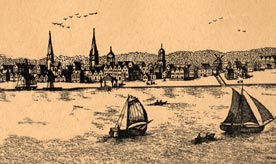
New York in 1767. E. Fritscher, Valentine's Manual.
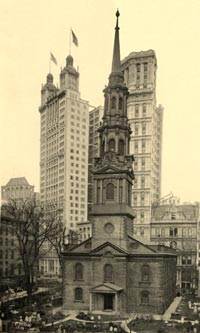
St. Paul's Church, with Park Row building (left) and St. Paul building (right), photo by A. Wittemann 1902.

New York in 1767. E. Fritscher, Valentine's Manual. |
 St. Paul's Church, with Park Row building (left) and St. Paul building (right), photo by A. Wittemann 1902. |
| In 1767, church spires were the most remarkable features of New York's downtown skyline view. But by 1902, the steeples of Trinity Church and St. Paul's were surrounded and dwarfed by the new "skyscrapers" of the financial district. |
|
On September 11, 2001, three churches were standing directly
in the shadow of the World Trade Center's twin towers. Two of them, shielded
by other structures, survived. One did not. | |
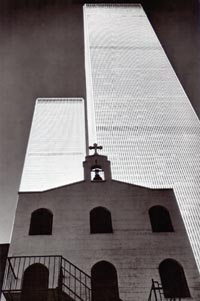
|
A humble whitewashed church, built by hard-working immigrants in 1916, St. Nicholas Greek Orthodox Church welcomed congregants, sailors and visitors from all over the world. At 9:59 a.m, September 11, "the white altar candles were violently extinguished. The sweet scent of incense was blown away by the acrid smell of senseless destruction. And the walls came tumbling down." The Greek Orthodox Church in America has pledged to rebuild the church and has founded The September 11 Relief Fund for the children of the missing, according to His Eminence Archbishop Demetrios, "to reaffirm our belief in all that is good and right." |
| Historic St. Paul's Episcopal Chapel and a smaller Roman Catholic Chapel, St. Joseph's, suffered only minor damage. Like all buildings near Ground Zero, they were first enveloped in a cloud of black smoke and then covered - inside and out - with thick layers of white dust that left much of lower Manhattan eerily reminiscent of Pompeii. Most poignantly, flying papers blown from desktops drifted down, blanketing the historic churchyards and their graves. Both churches were opened soon after the collapse of the twin towers to serve the rescue teams. | 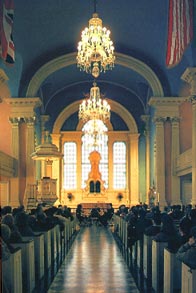 Interior St. Paul's Chapel, New York Public Library Picture Collection. |
| St. Joseph's Roman Catholic Chapel, located in the Gateway Plaza complex just west of the Trade Center, was turned into an emergency supply center by a small band of neighborhood volunteers. According to a story by Dan Barry in the New York Times (September 23, 2001) "the red-upholstered chairs were moved out, replaced by stacks of boxes. Someone used a red pen on the chapel's walls to mark places where certain supplies were to be stored. To the right of a statue of St. Francis of Assisi was written 'meds'; to the left, 'clothes.' |
|
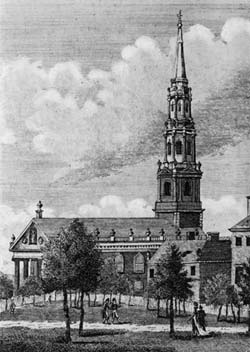 St. Paul's 1795, from The New-York Magazine or Literary Repository. |
Historical Footnote: |
|
MORE ABOUT THE CHURCHES
AFTERMATH
REDESIGN AND MEMORIAL
VISITING GROUND ZERO (AND DOWNTOWN MANHATTAN)
|
|